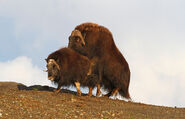
Muskox in the Lüneburg Heath wildlife park, Germany.
Musk oxen live in the frozen Arctic and roam the tundra in search of the roots, mosses, and lichens that sustain them. In winter, they use their hooves to dig through snow to graze on these plants. During the summer, they supplement their diet with Arctic flowers and grasses, often feeding near water.
These animals have inhabited the Arctic for many thousands of years, and their long shaggy hair is well adapted to the frigid climate. The outer hairs, called guard hairs, cover a second, shorter undercoat that provides additional insulation in winter. This undercoat falls out when temperatures climb at winter's end. Female musk-oxen carry their calves during an eight-month pregnancy, but after birth there is little time to waste. The infants are able to keep up with their mothers and the rest of the herd within a few hours.
Musk-oxen are herd animals, and groups of two or three dozen animals are sometimes led by a single female. Herds use cooperation to deal with predation by wolves or dogs. When threatened, they "circle the wagons" and array themselves with their young in the middle and their sharp horns facing outward toward their foes. A cornered musk-ox can be a fearsome enemy, charging with its massive bulk and attempting to use its horns to deadly effect. Such defenses are not terribly effective against human hunters, who killed great numbers of musk-oxen for their hides and meat. Today, legislation protects herds in Alaska, Norway, and Siberia, where the animals live on preserves.
Mating season peaks in mid August when males compete for dominance. One dominant bull will drive the other males out of the herd. Non-breeding males will often for herds of 5 – 10 and wander the tundra alone. Males can get extremely aggressive during breeding season and chase off any other animal that approaches, even birds. To prove their dominance, males have confrontations known as ruts. During these ruts, males emit a lion-like roar and run towards each other, crashing their heads together. Females are sexually mature at 2 years of age. Males reach maturity much later at around 5 years. The gestation period is 8 – 9 months and almost all births are single calves. The young are nursed for around a year but may begin to eat grass as soon as a week after birth. The young huddle in its mothers long coat to keep warm.
The life span of a Musk Ox is around 20 – 24 years.














